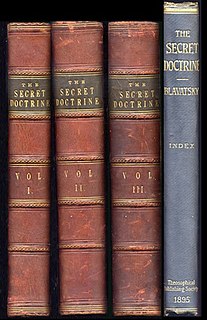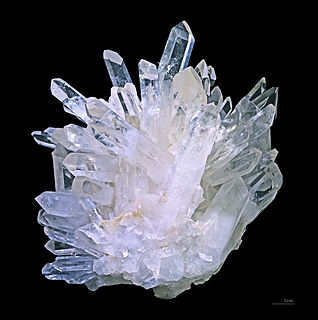
An atom is the smallest constituent unit of ordinary matter that constitutes a chemical element. Every solid, liquid, gas, and plasma is composed of neutral or ionized atoms. Atoms are extremely small; typical sizes are around 100 picometers. They are so small that accurately predicting their behavior using classical physics – as if they were billiard balls, for example – is not possible. This is due to quantum effects. Current atomic models now use quantum principles to better explain and predict this behavior.

Epicurus was an ancient Greek philosopher and sage who founded a highly influential school of philosophy now called Epicureanism. He was born on the Greek island of Samos to Athenian parents. Influenced by Democritus, Aristotle, Pyrrho, and possibly the Cynics, he turned against the Platonism of his day and established his own school, known as "the Garden", in Athens. Epicurus and his followers were known for eating simple meals and discussing a wide range of philosophical subjects, and he openly allowed women to join the school as a matter of policy. An extremely prolific writer, he is said to have originally written over 300 works on various subjects, but the vast majority of these writings have been lost. Only three letters written by him—the Letters to Menoeceus, Pythocles, and Herodotus—and two collections of quotes—the Principle Doctrines and the Vatican Sayings—have survived intact, along with a few fragments and quotations of his other writings. Most knowledge of his teachings comes from later authors, particularly the Roman poet Lucretius, the biographer Diogenes Laërtius, the statesman Cicero, and the philosophers Philodemus and Sextus Empiricus.
Materialism is a form of philosophical monism that holds that matter is the fundamental substance in nature, and that all things, including mental states and consciousness, are results of material interactions. According to philosophical materialism, mind and consciousness are by-products or epiphenomena of material processes, without which they cannot exist. This concept directly contrasts with idealism, where mind and consciousness are first-order realities to which matter is subject and material interactions are secondary.

Ontology is the philosophical study of being. More broadly, it studies concepts that directly relate to being, in particular becoming, existence, reality, as well as the basic categories of being and their relations. Traditionally listed as a part of the major branch of philosophy known as metaphysics, ontology often deals with questions concerning what entities exist or may be said to exist and how such entities may be grouped, related within a hierarchy, and subdivided according to similarities and differences.
An exotic atom is an otherwise normal atom in which one or more sub-atomic particles have been replaced by other particles of the same charge. For example, electrons may be replaced by other negatively charged particles such as muons or pions. Because these substitute particles are usually unstable, exotic atoms typically have very short lifetimes and all currently observed atoms cannot persist under normal conditions.
Pluralism is a term used in philosophy, meaning "doctrine of multiplicity", often used in opposition to monism and dualism. The term has different meanings in metaphysics, ontology, epistemology and logic.
Impermanence, also known as the philosophical problem of change, is a philosophical concept that is addressed in a variety of religions and philosophies.

Transcendental idealism is a doctrine founded by German philosopher Immanuel Kant in the 18th century. Kant's doctrine is found throughout his Critique of Pure Reason (1781). Kant argues that the conscious subject cognizes objects not as they are in themselves, but only the way they appear to us under the conditions of our sensibility. Thus Kant's doctrine restricts the scope of our cognition to appearances given to our sensibility and denies that we can possess cognition of things as they are in themselves, i.e. things as they are independently of how we experience them through our cognitive faculties.

Logical atomism is a philosophy that originated in the early 20th century with the development of analytic philosophy. Its principal exponent was the British philosopher Bertrand Russell. It is also widely held that the early work of his Austrian-born pupil and colleague, Ludwig Wittgenstein, defend a version of logical atomism. Some philosophers in the Vienna Circle were also influenced by logical atomism. Gustav Bergmann also developed a form of logical atomism that focused on an ideal phenomalistic language, particularly in his discussions of J.O. Urmson's work on analysis.

The Secret Doctrine, the Synthesis of Science, Religion and Philosophy, a book originally published as two volumes in 1888 written by Helena Blavatsky. The first volume is named Cosmogenesis, the second Anthropogenesis. It was an influential example of the revival of interest in esoteric and occult ideas in the modern age, in particular because of its claim to reconcile ancient eastern wisdom with modern science.

Ajivika is one of the nāstika or "heterodox" schools of Indian philosophy. Purportedly founded in the 5th century BCE by Makkhali Gosala, it was a śramaṇa movement and a major rival of vedic religion, early Buddhism and Jainism. Ājīvikas were organised renunciates who formed discrete communities. The precise identity of the Ajivikas is not well known, and it is even unclear if they were a divergent sect of the Buddhists or the Jains.
Clinamen is the Latin name Lucretius gave to the unpredictable swerve of atoms, in order to defend the atomistic doctrine of Epicurus. In modern English it has come more generally to mean an inclination or a bias.
Atomism is a natural philosophy proposing that the physical world is composed of fundamental indivisible components known as atoms.

The 28 fundamental beliefs are the core beliefs of Seventh-day Adventist theology. Adventists are opposed to the formulation of creeds, so the 28 fundamental beliefs are considered descriptors, not prescriptors; that is, that they describe the official position of the church but are not criteria for membership. These beliefs were originally known as the 27 fundamental beliefs when adopted by the church's General Conference in 1980. An additional belief was added in 2005. The Seventh-day Adventist Bible Commentary is a significant expression of Adventist theological thought.

Jain philosophy is the oldest Indian philosophy that separates body (matter) from the soul (consciousness) completely. Jain philosophy deals with reality, cosmology, epistemology and Vitalism. It attempts to explain the rationale of being and existence, the nature of the Universe and its constituents, the nature of soul's bondage with body and the means to achieve liberation.

In classical physics and general chemistry, matter is any substance that has mass and takes up space by having volume. All everyday objects that can be touched are ultimately composed of atoms, which are made up of interacting subatomic particles, and in everyday as well as scientific usage, "matter" generally includes atoms and anything made up of them, and any particles that act as if they have both rest mass and volume. However it does not include massless particles such as photons, or other energy phenomena or waves such as light or sound. Matter exists in various states. These include classical everyday phases such as solid, liquid, and gas – for example water exists as ice, liquid water, and gaseous steam – but other states are possible, including plasma, Bose–Einstein condensates, fermionic condensates, and quark–gluon plasma.

In the physical sciences, a particle is a small localized object to which can be ascribed several physical or chemical properties such as volume, density or mass. They vary greatly in size or quantity, from subatomic particles like the electron, to microscopic particles like atoms and molecules, to macroscopic particles like powders and other granular materials. Particles can also be used to create scientific models of even larger objects depending on their density, such as humans moving in a crowd or celestial bodies in motion.

A Boy and His Atom is a 2013 stop-motion animated short film released on YouTube by IBM Research. The movie tells the story of a boy and a wayward atom who meet and become friends. It depicts a boy playing with an atom that takes various forms. One minute in length, it was made by moving carbon monoxide molecules with a scanning tunneling microscope, a device that magnifies them 100 million times. These two-atom molecules were moved to create images, which were then saved as individual frames to make the film. The movie has been recognized by the Guinness Book of World Records as the World's Smallest Stop-Motion Film.

The idea that matter consists of smaller particles and that there exists a limited number of sorts of primary, smallest particles in nature has existed in natural philosophy at least since the 6th century BC. Such ideas gained physical credibility beginning in the 19th century, but the concept of "elementary particle" underwent some changes in its meaning: notably, modern physics no longer deems elementary particles indestructible. Even elementary particles can decay or collide destructively; they can cease to exist and create (other) particles in result.
The Fifth Chapter of the Vaisheshika Sutras of Kanada deals with the notion of action and the connected concept of effort; and also deals with the various special phenomenon of nature to the supersensible force, called Adrishta.












